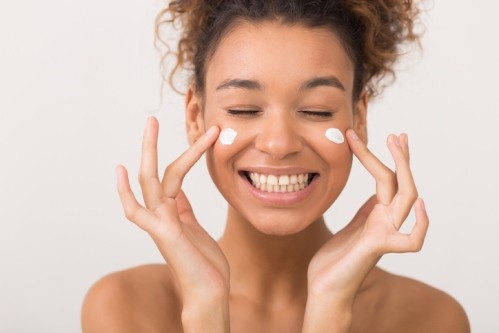
Why is it important to exfoliate the skin? What are the types of exfoliation and kitchen products that can help you? Are there any rules for exfoliation and how should you clean the skin according to its type? Learn all about exfoliation and why it is important for your skin to be healthy and beautiful.
Why is it important to exfoliate the skin?
At about 30 days, the skin naturally secretes dead cells, which are replaced by new ones. Sometimes they fall alone, but other times they need a little help. If the dead cells are not removed, the skin becomes “scaly” and dry, the pores become clogged. To avoid this, the skin needs exfoliation – a process to remove dead skin cells.
Benefits of exfoliation
Exfoliation has short-term and long-term benefits. Immediately after cleansing, the skin acquires a fresher look. Regularly exfoliated skin tolerates different types of cosmetics better.
Frequent and proper exfoliation reduces the likelihood of clogging the pores and the appearance of pimples.
In the long run, exfoliation increases the production of collagen, key to a beautiful and youthful appearance of the skin.
Remember that the skin of the whole body needs exfoliation, not just that of the face. Among the most commonly forgotten areas are the décolleté, arms, lips, and thighs.
Types of exfoliation
Exfoliation can be divided into two types – manual and chemical. Scrubs, scrubs, brushes, sponges, gloves, pebbles are used for hand exfoliation – everything to “rub” the skin. Hydroxy acids and retinol are used in acid exfoliation, along with enzymes to stimulate the production of new cells.
Exfoliation with cosmetics or kitchen products
In drugstores and large stores, you will find piles of cosmetic products for exfoliation. Choose the one your skin needs right now. Keep in mind that sometimes the skin changes (with age, according to the season, etc.), and with that, you have to replace the product.
With kitchen products, you can easily prepare a natural scrub. Home scrubs are more gentle, rarely cause a reaction, and are easy to prepare.
Mix 1/2 tsp ground coffee, 1/2 tsp sugar, 2 tsp fresh milk, and 1 tsp honey. Stir and apply to damp skin. Massage with gentle circular motions for a few minutes. Rinse with lukewarm water. Store the scrub in the refrigerator.
Homemade scrub with coconut oil
1/2 tsp melted coconut oil, 1/4 tsp honey, 1/2 tsp sugar, and 2 tbsp oat bran. Mix the products to obtain a thick paste. Apply to damp skin, massage, and wash off.
Chemical exfoliation
Acids are used in chemical exfoliation. It can be made at home. Our advice is to apply it after consulting a dermatologist.
Alpha hydroxy acids (AHAs) are a type of water-soluble acid derived from fruits. Among the best-known alpha hydroxy acids are glycolic, lactic, and citric. Alpha hydroxy acids also help with hyperpigmentation (spots, acne scars, etc.), enlarged pores, fine wrinkles, and uneven complexion.
Beta hydroxy acids (BHA) do not dissolve in water, but in fats. They penetrate deeper into the skin. They are mainly used for oily and acne-prone skin. The most popular type of beta hydroxy acid is salicylic acid. They are used for acne and to reduce inflammation.
Rules for skin exfoliation
Do not mix or alternate products
As tempting as it is, do not use 2 or more scrubs at the same time. It is also not appropriate to alternate them, ie. one this week, another next. This can cause skin irritation, redness, or inflammation. An exception is the combination of skin, the tips for which you will find a little below in the text.
Always exfoliate on damp skin
The exfoliant is always applied to damp skin so as not to cause redness. It is also a good idea to remove any make-up with a make-up remover beforehand. Thus, the results of exfoliation will be better.
Be gentle
Apply an exfoliant to the skin, be gentle, and do not apply pressure. Smooth massage movements in a circle are recommended.
Do not neglect the massage
Massage is an important part of exfoliation. It is not enough to simply apply the product. Massage helps to remove dead skin cells and stimulates blood circulation.
Do not overdo it
There are many opinions on how often the skin should be exfoliated. Some celebrities, such as Beyonce and Elle McPherson, believe that this procedure should be applied every day and even twice a day. However, dermatologists and beauticians do not agree. Most recommend exfoliating the skin once or twice a week. Excessive exfoliation will damage the skin, dry it out, and even age it.
The exception is oily and acne-prone skin, which may need exfoliation every day or every other day, but only after consultation with a dermatologist.
Exfoliation according to skin type
Sensitive skin – beta hydroxy acids are best suited for exfoliating sensitive skin. But ALWAYS consult a dermatologist, because sensitivity may be a sign of another unmanifested or unfamiliar condition that requires treatment.
Normal skin – you can use any scrub. Your skin is unlikely to be irritated and most often relies on personal preferences.
Dry skin – alpha hydroxy acids are best for your skin.
Combination skin – for best results use a homemade scrub or brush on areas with oily skin, and on those with dry – alpha hydroxy acid. It is good to treat different areas on two consecutive days.
Acne skin – retinoids, salicylic and glycolic acid are best for you




